 |
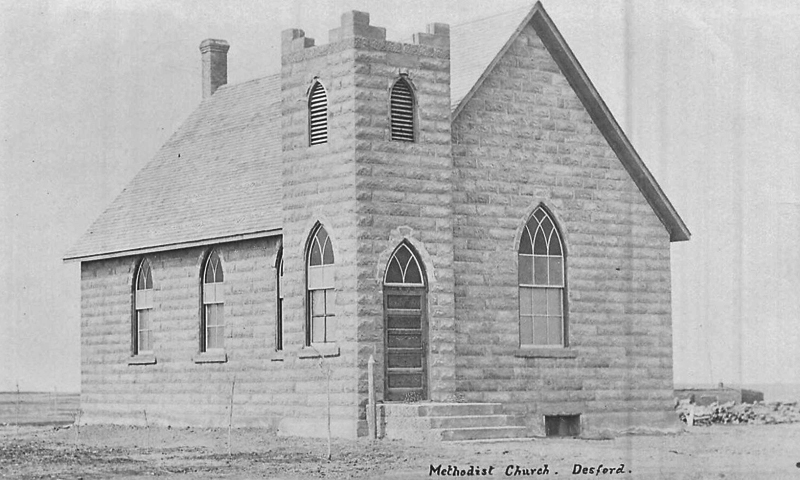
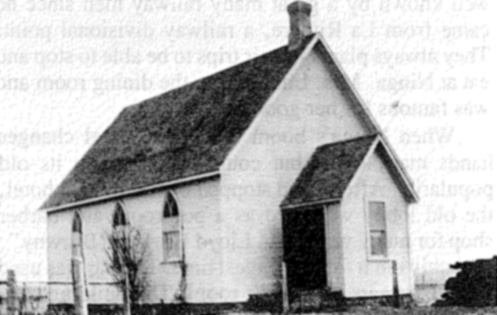
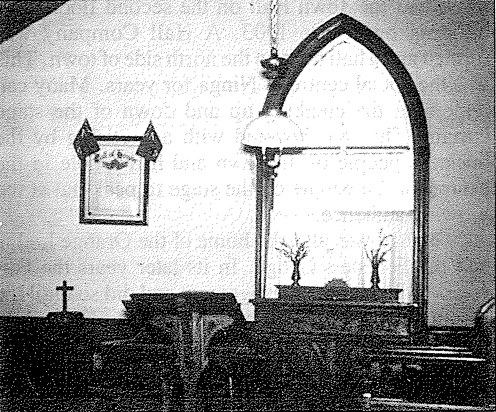

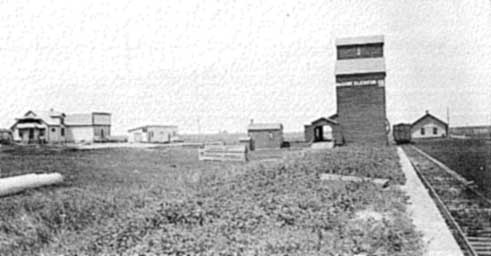
Desford
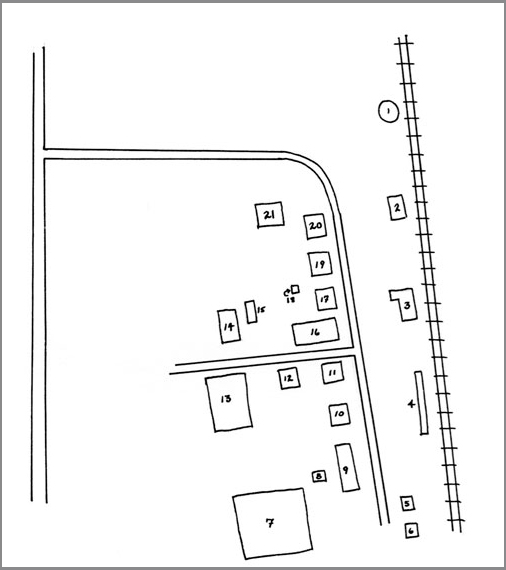
1. Water Tower
2. 2. GN Station
3. 3. McCabe Elevator
4. Loading Platform
5. Section House
6. Bunk House
7. Ball Diamond / Picnic Site
8. Church Barn
9. Anglican Church
10. Bridger House 11. McDonald House
12. H. Bridger, Blacksmith
13. Desford Hall (Former Shoe Shop)
14. Methodist Church
15. Church Barn
16. Skating Rink
17. Davis Store
18. Oil Shed
19. Warehouse
20. 1st Site, Neuman Store
21. J. Bridger. Sr. Blacksmith
Origins
In 1882 Mr. Erskin Nichol moved from Ontario to the northern slopes of Turtle Mountain and established a store and post office. Mr. Frederick. R. Porritt, who settled in the area in 1881, opened a second store equipped with stopping place facilities for other land-seekers heading west. Porritt later became the postmaster of the town of Desford which grew from Nichol's store. Frederick Porritt was joined by his brother Herbert and together they purchased a steam-run threshing machine which was the first one to appear in southwest Manitoba. The Porritt brothers settled in the southwest corner of Manitoba as a result of L. O. Armstrong's promotion.
The first Land Titles Office which was operated out of a tent by Land Commissioner Mr. Alfred Codd was located nearby Desford. (15-2-20. 1956 Beckoning Hills records it as being a Mr. Code on 12-2-20)
Desford received a boost in activity after 1905 when the Great Northern Railway laid tracks through the town on it's way from St. John, North Dakota, to Brandon, Manitoba.
The site we now call Old Desford (22-2-20) was one of the first stopping places on the Boundary Commission Trail.
For some time, along with Wakopa and (Old) Deloriane, it was one of the few places for pioneers to get supplies.
It was also the site of one the first sawmills. Lumber from Fox’s Mill was used to build the first houses and business places in Boissevain.
Community Development
With the arrival of the Great Northern Line nearby, a village called Desford grew along the rail line at (W14-2-19) . Mr. Davis moved his store from Adelpha. An elevator, two churches, a blacksmith shop, a garage and community hall, were established. At one time the population was about thirty. The village declined with the closing of the GNR in 1936, and the site was deserted by 1970.
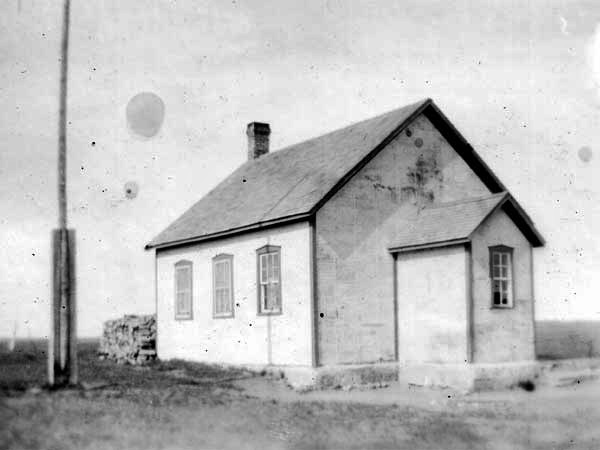
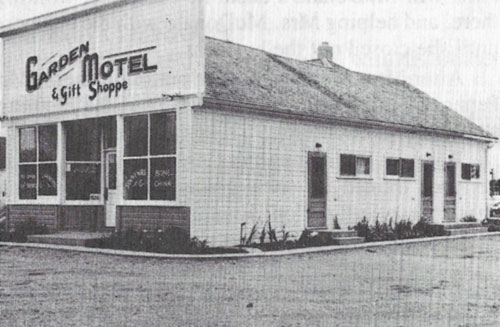
The former Desford store - moved to Boissevain.
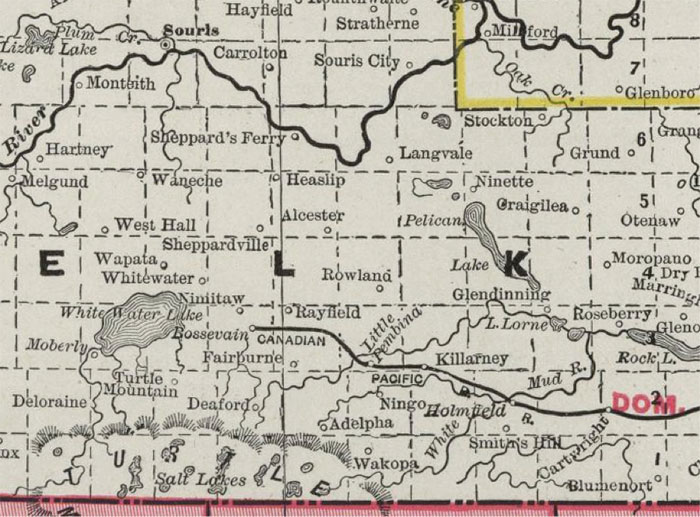
The original site of Desford is on this map from the 1880's.
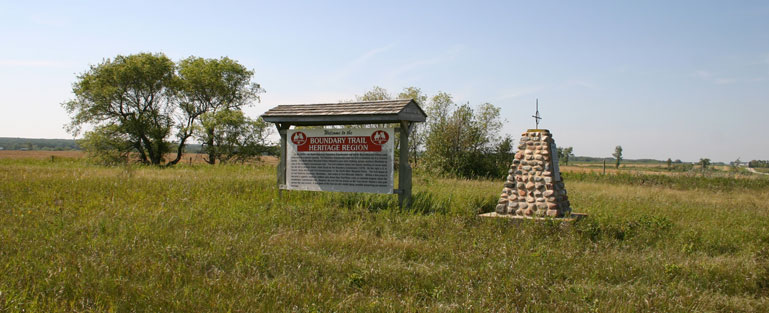
Site of "Old" Desford - near the railway site of Horton.
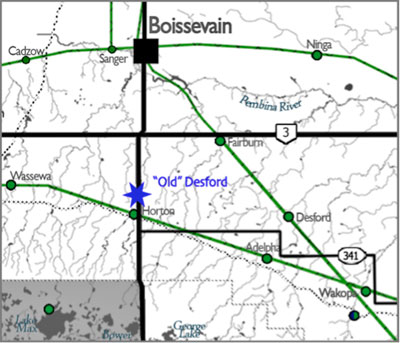
 |
 |

MapPlus...
Heritage Site Maps...
More History...from Beckoning Hills Revisited
The
Desford community began in the late 1870's. There are many reminders of
the early days of the birth of the district. The Old Commission Trail
on which the Red River carts came, is still visible. Arrow heads, stone
hammers, tomahawks, bows and arrows remind us that Indians once roamed
here. Buffalo skulls and elk horns have been found in a swamp on
section 35-1-19 W.P.M.
The Canadian National Railway was pushed through the district in 1906. Wakopa, Adelpha and Horton were three other stations on the line. It was lifted in 1960. In 1908 the Great Northern Railway was put down through the present area of Desford.
New Desford.
After the coming of the G.N.R., Desford grew. Mr. and Mrs. H. Davis moved their store from Adel- pha to Desford, a McCabe Elevator was built, a section house and two or three residences and a station were built. These were all tom down when the track was lifted. Davis' store burned in 1925 and was replaced by a Red and White store, run by H. Davis, followed by his son, Gordon, and Charles Mc- Cullagh.
There were two churches, Anglican and United, . a Community Hall, the store, post office with resi- denceadjoining (later moved to Boissevain to be used as the Garden Motel), a large storehouse and garage, an oil station, a blacksmith shop and another house which made up this hamlet of yesterday. At one time the population of Desford was about thirty.
Adelpha was made up of a station, loading plat- form and a stockyard after the removal of the store. A foundation was once laid for a second elevator, but it was never built.
West Lake School was two and a half miles south and east of Desford. The original school was built in 1885 half a mile south of the other. Mrs. Richardson was the first teacher. Frank Fox, Mrs. Leonard Taylor and Mrs. A. Gregory were among those who at- tended the first year.
The next school was built in 1918 and was a great improvement over the old one. New seats, desks and a piano were appreciated. There was a large library and a good supply of books. A hot air furnace re- placed the old heater. A water cooler and dipper replaced the traditional pail and dipper. A variety of subjects were taught and pupils attended up to grade eleven. Wall posters and individual towels indicated that emphasis was placed on teaching practical health rules. The well-worn ball diamond, fox and goose ring and other playground equipment showed that the children made good use of recess and noon hour time. The school was closed in 1960. Mrs. James Scott and Mrs. Herb Barwick were teachers who married and remained in the district.
Wood Lake School was two and a half miles west and south of Desford. It was built in 1893 on the northeast of 8-2-19 W.P.M. The first teacher was A. L. Webster and the enrollment was twenty-six. Both school grounds were greatly improved by the plant- ing oftrees. Dr. Lee, the local veterinarian, offered a shield for the best-kept school grounds. Wood Lake School closed in 1966.
Desford had a Beef Ring Association which was formed in 1914. The first executive included Ed Shannon, Joe Boyd and George Ryan. The slaughter house was built on the northwest quarter of 26-3-19 W.P.M. There were about twenty shareholders. Mrs. George Wright said that her father, Frank Taylor was the first killer and did this for five years. Others were Howard and Wilfred Boyd, Herb Barwick and his father, Thomas and Joe Jasper. Joe also ran a beef ring at Wakopa along with his father.
To keep the meat shared in the beef ring, people built ice houses. A hole was dug in the ground and a small building erected over it. Sawdust was brought from a sawmill and ice from Lake William or Wood Lake. The sawdust was packed around the ice in the hole, and the ice lasted most of the summer. Meat, cream and butter were kept in the ice house. Some people hung these perishable products down the well to keep them cool. Before these were devised, salt pork was the main meat.
The early winter of 1928 brought together a gathering to discuss the building of a new hall in Desford. The district was canvassed, and shares sold. A nice large building, 28 by 50 feet, served for some 35 years, when it was sold to Mr. Hicks, who lived three 3 miles south.
The Canadian National Railway was pushed through the district in 1906. Wakopa, Adelpha and Horton were three other stations on the line. It was lifted in 1960. In 1908 the Great Northern Railway was put down through the present area of Desford.
New Desford.
After the coming of the G.N.R., Desford grew. Mr. and Mrs. H. Davis moved their store from Adel- pha to Desford, a McCabe Elevator was built, a section house and two or three residences and a station were built. These were all tom down when the track was lifted. Davis' store burned in 1925 and was replaced by a Red and White store, run by H. Davis, followed by his son, Gordon, and Charles Mc- Cullagh.
There were two churches, Anglican and United, . a Community Hall, the store, post office with resi- denceadjoining (later moved to Boissevain to be used as the Garden Motel), a large storehouse and garage, an oil station, a blacksmith shop and another house which made up this hamlet of yesterday. At one time the population of Desford was about thirty.
Adelpha was made up of a station, loading plat- form and a stockyard after the removal of the store. A foundation was once laid for a second elevator, but it was never built.
West Lake School was two and a half miles south and east of Desford. The original school was built in 1885 half a mile south of the other. Mrs. Richardson was the first teacher. Frank Fox, Mrs. Leonard Taylor and Mrs. A. Gregory were among those who at- tended the first year.
The next school was built in 1918 and was a great improvement over the old one. New seats, desks and a piano were appreciated. There was a large library and a good supply of books. A hot air furnace re- placed the old heater. A water cooler and dipper replaced the traditional pail and dipper. A variety of subjects were taught and pupils attended up to grade eleven. Wall posters and individual towels indicated that emphasis was placed on teaching practical health rules. The well-worn ball diamond, fox and goose ring and other playground equipment showed that the children made good use of recess and noon hour time. The school was closed in 1960. Mrs. James Scott and Mrs. Herb Barwick were teachers who married and remained in the district.
Wood Lake School was two and a half miles west and south of Desford. It was built in 1893 on the northeast of 8-2-19 W.P.M. The first teacher was A. L. Webster and the enrollment was twenty-six. Both school grounds were greatly improved by the plant- ing oftrees. Dr. Lee, the local veterinarian, offered a shield for the best-kept school grounds. Wood Lake School closed in 1966.
Desford had a Beef Ring Association which was formed in 1914. The first executive included Ed Shannon, Joe Boyd and George Ryan. The slaughter house was built on the northwest quarter of 26-3-19 W.P.M. There were about twenty shareholders. Mrs. George Wright said that her father, Frank Taylor was the first killer and did this for five years. Others were Howard and Wilfred Boyd, Herb Barwick and his father, Thomas and Joe Jasper. Joe also ran a beef ring at Wakopa along with his father.
To keep the meat shared in the beef ring, people built ice houses. A hole was dug in the ground and a small building erected over it. Sawdust was brought from a sawmill and ice from Lake William or Wood Lake. The sawdust was packed around the ice in the hole, and the ice lasted most of the summer. Meat, cream and butter were kept in the ice house. Some people hung these perishable products down the well to keep them cool. Before these were devised, salt pork was the main meat.
The early winter of 1928 brought together a gathering to discuss the building of a new hall in Desford. The district was canvassed, and shares sold. A nice large building, 28 by 50 feet, served for some 35 years, when it was sold to Mr. Hicks, who lived three 3 miles south.
Desford
had "Girl Guides", led by Marguerite McRuer. They had regular meetings,
and kept to the rules. In summer they camped at Lake William. Ball
players were in a league, and games were played in an area just south
of the Anglican Church. Banner- man , Lyons Hall and Wakopa took part.
Amos Hicks was the umpire. Players included Fred Orriss
(catcher),
Harts and Alton Orriss, Jimmie Scott, Geordie Scott, Ernie Davidson,
Frank Gregory, Herb Barwick and Jim Cossar. From out in the field, Jim
would call "Tighten your belts, boys!"
Pioneer names to be remembered are Shannon, Allen (farmstead) and Henderson (farmstead).
A time came when the railway was lifted from Brandon to St. John and trucks were taking over from railways. The Davis store had suffered from fire and a new one was built. Later on Mr. Davis and family moved to British Columbia and the new building was sold to Charlie McCullagh, who in tum sold it to Lysle Robb of Boissevain who moved it into town where it is now part of the Garden Motel, owned by Bruce Orriss, grandson of Desford's Arthur Orriss.
About the last residents in Desford were Herb and Ida Barwick, and Art Abrahamson, General Garage man, whose shop was designated by a large shiny star. The churches have been tom down and all other buildings have disappeared. The site of this pioneer village is marked by a small sign which was erected in 1970. It reads:
"Site of Desford Village on Great Northern Railroad V4 mile east of this location. The village consisted of a Community Hall, United Church, Anglican Church, Blacksmith Shop, General Store and a few residents. 1900-1970"
Wood was cut in the Turtle Mountain, as were logs for sawing into lumber. There were several sawmills in the area including the Torrence, Fox, Scott and Wakopa mills.
When the G.N. Railway was brought from the United States to Brandon, the store at Adelpha, owned by Mr. Crummer, was moved the four miles to Desford. Herb Davis moved it with the only available means - horse power. Sixteen teams, many farmers and all the chains in the country were used to move it in the spring. In places their path can still be seen across 10-2-19 and 15-2-19 W.P.M. Both parcels of land belonged to Mr. Sturt.
About 1890 the Maple Grove Syndicate was formed to buy a thresher. Members were Charlie Gregory, Robert Gregory, 1. B. Brown, Andrew Cos- sar, George Durston, James Maxwell and Harry Sturt. Mrs. Charles Gregory advanced the money and each member gave her a mortgage on a quarter section of land and paid ten percent interest until his share was paid.
Another syndicate included many of the same people and had Messers Durston, Gregory, Maxwell, Boyd, Ryan, Chester, Shannon, Washington and McCausland. These machines were portable and had straw carriers. In later years most of these men had traction steam outfits with straw blowers.
Well known names amongst the threshing outfit owners were Andrew Mechan and James Scott.
In 1908 the hamlet consisted of the water tower for the trains, the station for the Great Northern Railway, McCabe's Elevator, the loading platform, section house, bunk house, ball diamond and picnic grounds, the church bam, the Anglican Church, Bridger's house, McDonald's house, Horace Bridger's blacksmith shop, Desford Hall - former site of Ike Roger's shoe shop, the Methodist Church and the church bam, an open air skating rink, Davis' store, Neumann's store - moved and joined to- gether, and oil shed built later, a warehouse, rebuilt into a dwelling, the original site of Neumann's store and James Bridger Senior's blacksmith shop, which later burned. compiled by Beth Scott and Betty McRuer for
Boissevain Archives
Desford Methodist (United) Church
In 1893 Wood Lake School was built and shortly after Sunday School was organized - but not by telephone! Mr. Thomas Kempthorne was superinten-
Desford Methodist Church built in 1909.
dent for about thirty years. Mr. Farrow was in charge of the Bible class.
On November 14, 1898, several Boissevain lay- men were approved to conduct services at Wood Lake. The names of Musgrove, Currie, Bruin, Rogers, Oke, Holden, Venables and Johnston were among those who conducted the services. Every two weeks from December 11 to August 8 one of these men officiated.
Pioneer names to be remembered are Shannon, Allen (farmstead) and Henderson (farmstead).
A time came when the railway was lifted from Brandon to St. John and trucks were taking over from railways. The Davis store had suffered from fire and a new one was built. Later on Mr. Davis and family moved to British Columbia and the new building was sold to Charlie McCullagh, who in tum sold it to Lysle Robb of Boissevain who moved it into town where it is now part of the Garden Motel, owned by Bruce Orriss, grandson of Desford's Arthur Orriss.
About the last residents in Desford were Herb and Ida Barwick, and Art Abrahamson, General Garage man, whose shop was designated by a large shiny star. The churches have been tom down and all other buildings have disappeared. The site of this pioneer village is marked by a small sign which was erected in 1970. It reads:
"Site of Desford Village on Great Northern Railroad V4 mile east of this location. The village consisted of a Community Hall, United Church, Anglican Church, Blacksmith Shop, General Store and a few residents. 1900-1970"
Wood was cut in the Turtle Mountain, as were logs for sawing into lumber. There were several sawmills in the area including the Torrence, Fox, Scott and Wakopa mills.
When the G.N. Railway was brought from the United States to Brandon, the store at Adelpha, owned by Mr. Crummer, was moved the four miles to Desford. Herb Davis moved it with the only available means - horse power. Sixteen teams, many farmers and all the chains in the country were used to move it in the spring. In places their path can still be seen across 10-2-19 and 15-2-19 W.P.M. Both parcels of land belonged to Mr. Sturt.
About 1890 the Maple Grove Syndicate was formed to buy a thresher. Members were Charlie Gregory, Robert Gregory, 1. B. Brown, Andrew Cos- sar, George Durston, James Maxwell and Harry Sturt. Mrs. Charles Gregory advanced the money and each member gave her a mortgage on a quarter section of land and paid ten percent interest until his share was paid.
Another syndicate included many of the same people and had Messers Durston, Gregory, Maxwell, Boyd, Ryan, Chester, Shannon, Washington and McCausland. These machines were portable and had straw carriers. In later years most of these men had traction steam outfits with straw blowers.
Well known names amongst the threshing outfit owners were Andrew Mechan and James Scott.
In 1908 the hamlet consisted of the water tower for the trains, the station for the Great Northern Railway, McCabe's Elevator, the loading platform, section house, bunk house, ball diamond and picnic grounds, the church bam, the Anglican Church, Bridger's house, McDonald's house, Horace Bridger's blacksmith shop, Desford Hall - former site of Ike Roger's shoe shop, the Methodist Church and the church bam, an open air skating rink, Davis' store, Neumann's store - moved and joined to- gether, and oil shed built later, a warehouse, rebuilt into a dwelling, the original site of Neumann's store and James Bridger Senior's blacksmith shop, which later burned. compiled by Beth Scott and Betty McRuer for
Boissevain Archives
Desford Methodist (United) Church
In 1893 Wood Lake School was built and shortly after Sunday School was organized - but not by telephone! Mr. Thomas Kempthorne was superinten-
Desford Methodist Church built in 1909.
dent for about thirty years. Mr. Farrow was in charge of the Bible class.
On November 14, 1898, several Boissevain lay- men were approved to conduct services at Wood Lake. The names of Musgrove, Currie, Bruin, Rogers, Oke, Holden, Venables and Johnston were among those who conducted the services. Every two weeks from December 11 to August 8 one of these men officiated.
By
1909 a Methodist Church was built at Desford where Rev. Lobb was in
charge. In the meantime Rev. Fred Chapman had ministered in the area
for three years.
Some of the student ministers were: Harold Parr 1923, Carman Riggs, Scott Leith 1928, John Ross 1939.
Dan Matheson and Vera Ready were married there in 1942. Five other weddings were solemnized in Desford Church.
Leonard Taylor was prominent in the choir over the years.
The church was bought by Mac McRuer and tom down about 1960.
St. Mark's Anglican Church Desford St. Mark's Anglican Church, situated on S 14-2-19 W.P.M., in new Desford, was consecrated in
1909 by Archbishop Matheson, Primate of Canada. Petitioners for the formation were Rev. Cawley, Mr. and Mrs. 1. B. Bridger, William G. Munn, S. D. Whiting, Mr. and Mrs. Tom Bates, Mr. and Mrs. George Gregory, Mr. and Mrs. John Deacon, Mrs. Kingdon, Mrs. Frank Fox, George Durston, and Harry de la Wyche.
In the earlier years St. Mark's was linked to Ninga to form the parish of Ninga. The first Rector was Rev. Cawley with people's warden being 1. M. Deacon and Rector's warden was Robert Gregory. After many years of active service these two churches joined with St. Matthew's in Boissevain i
1960, to form the Diocesan Parish of St. Matthew's, Boissevain.
It was after many years of active and proud ser- vice, and owing to many old time parishoners having been called to higher service and others moving to new places of residence, that St. Mark's finally closed its doors. It was last used for a Christmas service, held in the little church on December 20, 1959.
When the Church closed Cecil M. Deacon was the People's Warden and secretary-treasurer. Fred Chandler was Rector's Warden.
The Church was sold to Elmer Boyd, who tore it down and used the lumber.
Desford Red Cross Society During the First World War the women of Des-
ford community worked untiringly knitting and sew- ing for the Red Cross. In the years that followed they were sent quilt patches, some of which were donated by the T. Eaton Company, and they made many quilts as well as layettes for the Red Cross. The meetings were held in their homes.
On November II, 1939, The Desford community organized the Desford Red Cross Society. Mr. Chap- man of Ninga acted a chairman. The first president was Mrs. Alan McRuer with vice-president - Mrs. Gordon Davis and secretary - Mrs. Herbert Barwick. The committees included members from all the families of the district including the Bridgers, Readys, Cochranes, Scotts, Deacons, Davidsons, Kempthornes, Clynes and Foxes. Besides the execu- tive they had budget, campaign, finance, canvass- ing, women's war work, transport and packing committees.
The supplies were sent in huge boxes to Adelpha station for pick up. The meetings were held in the Community Hall where the supplies were distributed to the ladies for knitting pullovers, helmets and socks. The ladies who sewed were even called upon to hem handkershiefs for the men in the forces. On completion the garments were packed in boxes and returned to the Red Cross headquarters by way of the Canadian National Railway at Adelpha. After the railway was taken up they took their boxes to Boisse- vain where Hammond's Transfer delivered them to Winnipeg, free of charge.
Gradually the hand work was phased out, as the need diminished, but the campaigning continued un- til 1965 when they amalgamated with Boissevain to become Boissevain and Desford Red Cross Society.
According to the record book, in the year 1940, thirty-four donations were made with pledges of wheat that was sold for an average of fifty cents per bushel.
Some of the student ministers were: Harold Parr 1923, Carman Riggs, Scott Leith 1928, John Ross 1939.
Dan Matheson and Vera Ready were married there in 1942. Five other weddings were solemnized in Desford Church.
Leonard Taylor was prominent in the choir over the years.
The church was bought by Mac McRuer and tom down about 1960.
St. Mark's Anglican Church Desford St. Mark's Anglican Church, situated on S 14-2-19 W.P.M., in new Desford, was consecrated in
1909 by Archbishop Matheson, Primate of Canada. Petitioners for the formation were Rev. Cawley, Mr. and Mrs. 1. B. Bridger, William G. Munn, S. D. Whiting, Mr. and Mrs. Tom Bates, Mr. and Mrs. George Gregory, Mr. and Mrs. John Deacon, Mrs. Kingdon, Mrs. Frank Fox, George Durston, and Harry de la Wyche.
In the earlier years St. Mark's was linked to Ninga to form the parish of Ninga. The first Rector was Rev. Cawley with people's warden being 1. M. Deacon and Rector's warden was Robert Gregory. After many years of active service these two churches joined with St. Matthew's in Boissevain i
1960, to form the Diocesan Parish of St. Matthew's, Boissevain.
It was after many years of active and proud ser- vice, and owing to many old time parishoners having been called to higher service and others moving to new places of residence, that St. Mark's finally closed its doors. It was last used for a Christmas service, held in the little church on December 20, 1959.
When the Church closed Cecil M. Deacon was the People's Warden and secretary-treasurer. Fred Chandler was Rector's Warden.
The Church was sold to Elmer Boyd, who tore it down and used the lumber.
Desford Red Cross Society During the First World War the women of Des-
ford community worked untiringly knitting and sew- ing for the Red Cross. In the years that followed they were sent quilt patches, some of which were donated by the T. Eaton Company, and they made many quilts as well as layettes for the Red Cross. The meetings were held in their homes.
On November II, 1939, The Desford community organized the Desford Red Cross Society. Mr. Chap- man of Ninga acted a chairman. The first president was Mrs. Alan McRuer with vice-president - Mrs. Gordon Davis and secretary - Mrs. Herbert Barwick. The committees included members from all the families of the district including the Bridgers, Readys, Cochranes, Scotts, Deacons, Davidsons, Kempthornes, Clynes and Foxes. Besides the execu- tive they had budget, campaign, finance, canvass- ing, women's war work, transport and packing committees.
The supplies were sent in huge boxes to Adelpha station for pick up. The meetings were held in the Community Hall where the supplies were distributed to the ladies for knitting pullovers, helmets and socks. The ladies who sewed were even called upon to hem handkershiefs for the men in the forces. On completion the garments were packed in boxes and returned to the Red Cross headquarters by way of the Canadian National Railway at Adelpha. After the railway was taken up they took their boxes to Boisse- vain where Hammond's Transfer delivered them to Winnipeg, free of charge.
Gradually the hand work was phased out, as the need diminished, but the campaigning continued un- til 1965 when they amalgamated with Boissevain to become Boissevain and Desford Red Cross Society.
According to the record book, in the year 1940, thirty-four donations were made with pledges of wheat that was sold for an average of fifty cents per bushel.